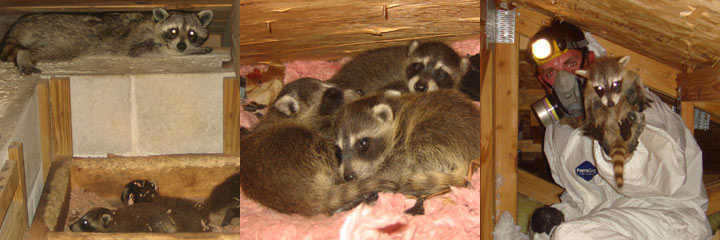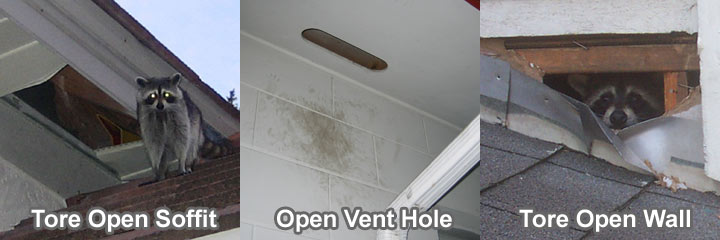When To Use It
It'll only work in the case of a female raccoon in an attic with young. And even then, it won't work all the time. For some people without experience, it won't work at all. It won't work in any other circumstance, and there's no such thing as a general all-purpose raccoon repellent.
How To Apply It
Pour the fluid on rags, tennis balls, or any medium that'll soak it up. Then toss these rags or tennis balls in various parts of the attic. Some pros also put a little near the entry/exit hole to the attic.
Where To Get It
Several online retailers sell it. Just do a search. I like wildlife control supplies, that's a good place to buy raccoon eviction fluid.
What If It Doesn't Work?
There's a good chance that it won't. In that case, do it the normal way - find the litter of baby raccoons and remove them by hand, and then use them to trap the mother raccoon.

Apply the raccoon eviction fluid in the attic in these areas.

You can also put some near the entry holes.
Explanation of product
Raccoon eviction fluid is a solution made of gland secretions and male raccoon urine. It comes in both liquid and paste forms. The idea is that a female raccoon knows that a male raccoon is a threat to any baby raccoons. Like many mammals, males will kill young that aren't theirs, so that females will go back into heat. Lions are notorious for this, as are many mammals. Sounds heartless, and I guess it is. It's how nature works - gene competition. At least that's the theory. Anyway, if a female smells a male raccoon in her den area, she might feel threatened and want to move the babies to a new, safer place. But this is a gamble for her. Moving them to a new place might expose them to further dangers. It's hard to survive, and raccoons know it. A female has to make a choice about the best chance of survival for her young. If she has an alternate den area to go to, then the application of evicition fluid might work. But it doesn't have a 100% success rate.
If eviction fluid doesn't work, you'll need to do some raccoon trapping to get the raccoons out of the attic. Read my home page again for every last bit of tips and tricks, or better yet, just hire one of my professional trappers, who can do a correct job in this very complex case of wildlife removal.
- - - - -
Customer email:
Hi David, enjoyed ( I think ) your excellent article on ridding raccoons. I have a fairly new boat house at Lake Anna Virginia and last weekend, I was blowing a large accumulation of leaves from the soffits with a leave blower, when much to my surprise, a large head peeked over the soffit, a raccoon, jumped down about 10 feet came towards me, thought twice about it, as I had a high powered blower in my hand and promptly took off running at least 300-400 feet and disappeared into the woods. I inspected the attic of the boat house and found floats that I had stored up there, covered with feces and eaten through. I got the floats down, dumped the feces into the lake, and cleaned the floats that were still usable. I planned to paint the little bit of flooring that is up in the attic that housed the floats.? After reading your article, I am now worried about the return, and more importantly removing the babies. I am sure you would tell me that it was a female and that there are babies there, although, I have not heard any noises. Is it possible that the babies haven't come yet ? and that we could make the environment non conducive to raccoon heaven ? Will raccoon eviction fluid encourage them to stay away? I would greatly appreciate any thoughts on a plan of action. The attic has only partial flooring and at the present time, I am not able to get to the far corners without adding more flooring. I will put down some additional boards this weekend. thanking you in advance for a response....
Go ahead and seal the holes shut. If it's a female with young, she'll just tear it open again. If not, the raccoon will likely find a new place to live, if you completely block the access. You can also try eviction fluid any time a female is in an attic space with young.
Raccoon eviction fluid is a solution made of gland secretions and male raccoon urine. It’s obviously not the most pleasant concoction, and I once saw some boys on the school bus douse someone else with it. Practical joking purposes aside, raccoon eviction fluid is one of those things that might work if the stars are all aligned. The theory behind its usage sounds practical; you have a female raccoon who moves into an attic to get away from dangerous males. In the wild, the male raccoons will kill any litters that aren’t their own, resulting in a female that is once again ready to breed. This devilry drives pregnant females out of the woods and into the safety of a human home. If you spray male scent around the area, the female is supposed to panic and remove her babies, taking them to a new location. That’s the way it’s supposed to work. Unfortunately, like many things on the market, raccoon eviction fluid only has a small success rate. It’s best used in tight spaces like chimneys. If you have a large, open attic, the smell probably won’t be potent enough to bother the female. Remember these animals are exceptionally smart, and sometimes scent alone isn’t enough to drive a female out of a warm, dark attic.
It'll only work in the case of a female raccoon in an attic with young. And even then, it won't work all the time. For some people without experience, it won't work at all. It won't work in any other circumstance, and there's no such thing as a general all-purpose raccoon repellent.
How To Apply It
Pour the fluid on rags, tennis balls, or any medium that'll soak it up. Then toss these rags or tennis balls in various parts of the attic. Some pros also put a little near the entry/exit hole to the attic.
Where To Get It
Several online retailers sell it. Just do a search. I like wildlife control supplies, that's a good place to buy raccoon eviction fluid.
What If It Doesn't Work?
There's a good chance that it won't. In that case, do it the normal way - find the litter of baby raccoons and remove them by hand, and then use them to trap the mother raccoon.

Apply the raccoon eviction fluid in the attic in these areas.

You can also put some near the entry holes.
Explanation of product
Raccoon eviction fluid is a solution made of gland secretions and male raccoon urine. It comes in both liquid and paste forms. The idea is that a female raccoon knows that a male raccoon is a threat to any baby raccoons. Like many mammals, males will kill young that aren't theirs, so that females will go back into heat. Lions are notorious for this, as are many mammals. Sounds heartless, and I guess it is. It's how nature works - gene competition. At least that's the theory. Anyway, if a female smells a male raccoon in her den area, she might feel threatened and want to move the babies to a new, safer place. But this is a gamble for her. Moving them to a new place might expose them to further dangers. It's hard to survive, and raccoons know it. A female has to make a choice about the best chance of survival for her young. If she has an alternate den area to go to, then the application of evicition fluid might work. But it doesn't have a 100% success rate.
If eviction fluid doesn't work, you'll need to do some raccoon trapping to get the raccoons out of the attic. Read my home page again for every last bit of tips and tricks, or better yet, just hire one of my professional trappers, who can do a correct job in this very complex case of wildlife removal.
- - - - -
Customer email:
Hi David, enjoyed ( I think ) your excellent article on ridding raccoons. I have a fairly new boat house at Lake Anna Virginia and last weekend, I was blowing a large accumulation of leaves from the soffits with a leave blower, when much to my surprise, a large head peeked over the soffit, a raccoon, jumped down about 10 feet came towards me, thought twice about it, as I had a high powered blower in my hand and promptly took off running at least 300-400 feet and disappeared into the woods. I inspected the attic of the boat house and found floats that I had stored up there, covered with feces and eaten through. I got the floats down, dumped the feces into the lake, and cleaned the floats that were still usable. I planned to paint the little bit of flooring that is up in the attic that housed the floats.? After reading your article, I am now worried about the return, and more importantly removing the babies. I am sure you would tell me that it was a female and that there are babies there, although, I have not heard any noises. Is it possible that the babies haven't come yet ? and that we could make the environment non conducive to raccoon heaven ? Will raccoon eviction fluid encourage them to stay away? I would greatly appreciate any thoughts on a plan of action. The attic has only partial flooring and at the present time, I am not able to get to the far corners without adding more flooring. I will put down some additional boards this weekend. thanking you in advance for a response....
Go ahead and seal the holes shut. If it's a female with young, she'll just tear it open again. If not, the raccoon will likely find a new place to live, if you completely block the access. You can also try eviction fluid any time a female is in an attic space with young.
Raccoon eviction fluid is a solution made of gland secretions and male raccoon urine. It’s obviously not the most pleasant concoction, and I once saw some boys on the school bus douse someone else with it. Practical joking purposes aside, raccoon eviction fluid is one of those things that might work if the stars are all aligned. The theory behind its usage sounds practical; you have a female raccoon who moves into an attic to get away from dangerous males. In the wild, the male raccoons will kill any litters that aren’t their own, resulting in a female that is once again ready to breed. This devilry drives pregnant females out of the woods and into the safety of a human home. If you spray male scent around the area, the female is supposed to panic and remove her babies, taking them to a new location. That’s the way it’s supposed to work. Unfortunately, like many things on the market, raccoon eviction fluid only has a small success rate. It’s best used in tight spaces like chimneys. If you have a large, open attic, the smell probably won’t be potent enough to bother the female. Remember these animals are exceptionally smart, and sometimes scent alone isn’t enough to drive a female out of a warm, dark attic.